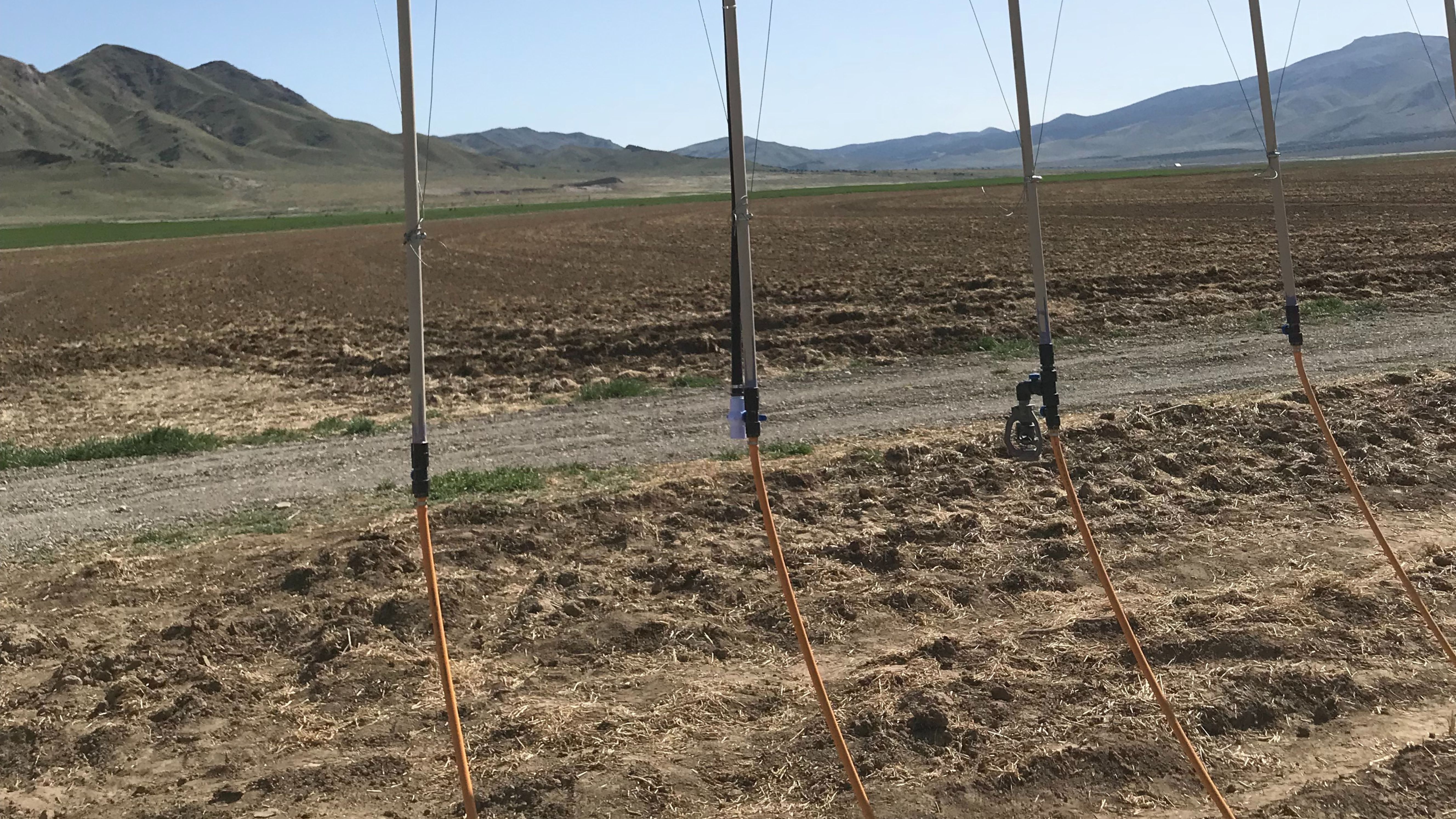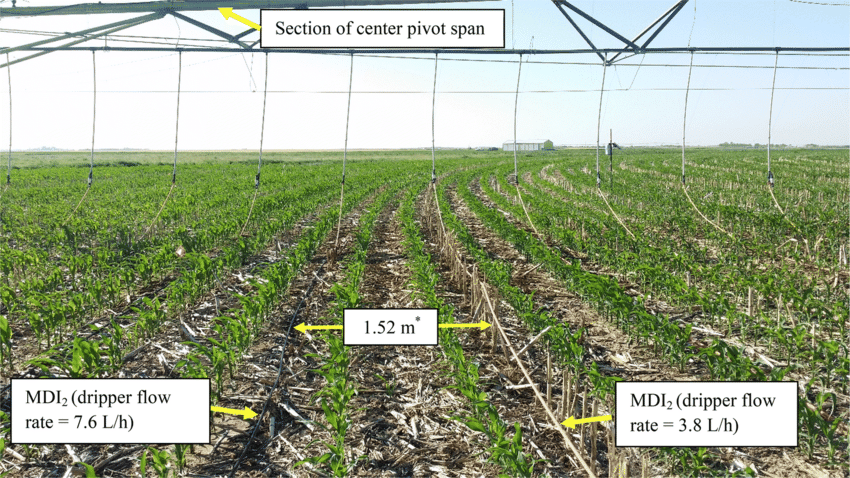What Is mobile drip irrigation?
Mobile Drip Irrigation (MDI) or Precision Mobile Drip Irrigation (PMDI) technologies for pivot and lateral/linear sprinkers have been on the market for over 15 years, and has been researched for over 40 years (Rawlins, 1974). Renewed interest has surfaced in recent years and additional MDI products are becoming more widely available. The basic concept of MDI is the attachment of drip tape or lines to mobile irrigation systems such as a pivot or lateral.
The drip tape is usually placed at close spacing, about 20-40 inches apart with 1 or 2 gallon per hour emitters spaced approximately every 6 inches . When attached to center pivots, the length of the drip tape increases with distance from the pivot point to uniformly apply water. This results in drip tape usually spanning from about 5 feet up to 100 feet long. Mobile drip irrigation systems can be attached to existing pivots, and can be used for both low profile crops (e.g., alfalfa or small grains) and high profile crops like corn.
Why might I consider it?
Crop production and yields are dependent on adequate water. In Utah, irrigation provides a large portion of that water. Applied irrigation water is used by crop transpiration, lost in the irrigation system (wind drift, etc.), evaporated from soil and foliage, or becomes unavailable to the crop from deep percolation and runoff. New technologies like MDI have the potential to improve irrigation efficiency thereby increasing water available to the crop and conserving water by reducing loss. Data on new MDI systems is still limited, but results from trials in Kansas (Kisekka et al., 2017; Schmidt, 2016) and Texas (O’Shaughnessy et al., 2017) have shown that MDI can maintain corn yields and improve water use efficiency.
This is done by reducing evaporation from soils and crop canopy, losses from wind drift, and providing a uniform irrigation to reduce deep percolation and stress in plants.If you are considering MDI on your farm, it will be important to carefully review its potential advantages and disadvantages. Potential advantages and disadvantages of MDI compared to other pivot irrigation systems are included in Table 1. Emphasis is placed on “potential” as data is still being collected in Utah and other parts of the country to validate advantages and disadvantages. This list is not exhaustive and may vary according to local field and climate conditions. It is recommended that growers consult with irrigation equipment suppliers, extension personnel, and other experienced users.
How is MDI adapted to existing pivots or laterals?
Mobile drip irrigation systems can be adapted to nearly any existing pivot or lateral irrigation system. Installation by an experienced professional is preferred, but growers have successfully installed their own systems. Configurations will differ depending on the application and the product. Thus, the following procedures will not apply to all systems, but provide a general outline of installation. Installation consists of attaching a wire cable system to support manifolds, hoses, and drip tape (Figure 2). Existing nozzles are removed and existing drops are connected to tubing that is installed horizontally along the support wire.
Every 20-40 inches along the horizontal tubing (depending on crop and soil type), three-way couplers are used to attach flexible hoses (approximately 10 feet) that rest on the soil surface. Drip tape is attached to these flexible hoses. The length of the drip tape varies across the pivot to give desired application rates. A similar design is used for high-line MDI systems to accommodate taller crops like corn. The difference is that the support wire is positioned about 10 feet above the ground instead of 5 feet in low-line systems. Another major difference is that PVC pipe or other rigid material is used to extend the drops, and additional wire supports are required to support each drop as it goes through the crop canopy.
Table 1 Potential advantages and disadvantages of mobile drip irrigation.
| Potential Advantages | Potential Disadvantages |
|---|---|
| Can be installed on existing irrigation equipment so costs are less than subsurface drip irrigation systems | Increased equipment cost compared to other pivot sprinkler packages |
| Improved soil infiltration for sloped fields or tight soils | Increased labor costs associated with installing and maintaining equipment |
| Enhanced irrigation application uniformity and efficiency | Increased filtration equipment and labor costs |
| Reduced soil and plant canopy evaporation and wind drift losses | Rodent and grazing animal damage to drip tape |
| Reduced diseases and other pests from having a drier canopy | Inability to physically wash spider mites from corn plants |
| Reduced flow rates to allow the use of lower-capacity pumps | Limitations on germination and chemigation options |
| Dry wheel tracks | Managing around drip tape that extends away from pivot |
How will crop management need to change?
Germination or heavy irrigations – Full soil coverage irrigations are sometimes needed for germination of crops. These types of irrigations are not well-suited for MDI. To accommodate this, germination packages can be included. Several options exist, but the simplest is to retain existing nozzles in addition to MDI. Simple manifolds with manual valves can be installed so irrigators can easily switch between overhead spray applications and MDI. Nozzle weights are generally removed for this application and nozzling packages need to be appropriately designed and installed for this specific application.
Planting – For MDI to be most effective, it is recommended that row crops like corn be planted either in a circle for center pivots or perpendicular to the direction of the lateral. This ensures that the drip tape does not 1) drag through standing crop which can increase drag on the pivot or lateral, 2) cause damage to plants, or 3) lift off the ground and ride up in the crop canopy which works against some of the purposes of MDI. Precision or careful planting to ensure even consistent spacing between rows is also recommended. Planting direction generally does not matter for non-row crops.

Fertigation and Chemigation – Foliar feeding with micronutrients, and other chemicals that require contact with plant leaves (e.g.. some pesticides) will not be effective with MDI. If these chemicals need to be applied, install and utilize a germination package (retaining existing nozzles that can be manually turned on) to apply chemicals on plant material. Some chemigation might be able to occur through the drip lines, but data on the effectiveness of various chemicals is still sparse.
Field Operations – Most field operations like tillage and harvesting may need to be modified to avoid hitting or damaging the drip tape that can extend up to 100 feet away from the center of the pivot or lateral trusses. To avoid this problem, some growers have found that drip tape can be coiled up by moving the irrigation system back-and-forth several times. This approach, however, is not always successful and can result in tangled and kinked lines that require manual un-kinking.
Steps to take when considering MDI
Serious consideration of MDI should include several steps to ensure that the water source, water quality, and water filtration are sufficient to support drip irrigation. Steps to take might include:
Consider your water source: Both surface and groundwater sources will work with MDI, but be aware that surface water usually contains more biological and other contaminants that may need to be filtered out.
Conduct a water quality analysis: This is a critical step in the consideration of MDI. Do not install a system before ensuring necessary filtration is in place. Collect a representative sample of the water supplying each pivot under consideration by triple flushing then filling a sample bottle. Fill the bottle as full as you can and send samples to a reputable water-testing lab as quickly as possible. Do not let the sample freeze. Have the sample analyzed for sediment and organics. Ensure proper filtration and/or water treatment: Filtration is a key component for successful and efficient MDI operation.
The type of contaminate will determine filtration needed. Most MDI systems require at least 80 mesh (177 micron) filtration. Sediment contamination may require sand separators. Biological contaminants can be filtered using various methods including injecting chlorine into pivot to clean lines and using various commercial filters. Several filtration options exist and range from manual to fully self-cleaning. Remember to factor in the cost of filtration equipment labor and installation when assessing MDI – it may add up to another $15,000 in equipment alone per pivot depending on the type of filtration needed.
Determine other systems changes that might be necessary: MDI systems are designed to operate at low pressures (<10 psi). They can self-regulate mainline pressures up to about 60 psi. Therefore, some adjustments to existing systems, such as the addition of a variable frequency drive, may be necessary to reduce system wear and tear and unnecessary energy costs.

What does it cost?
Cost of MDI is one of the first questions most growers have. There are currently two major MDI products on the market. These includes Dragon-Lines and NetaFim whose product is termed PMDI. Prices for MDI equipment and installation on existing pivots or laterals will vary by access to suppliers, field conditions, and other factors. Growers might anticipate spending about $150-$200 per acre for equipment and installation of MDI, but should consult with suppliers for more precise quotes. This estimated price does not include filtration, pressure regulation, and maintenance costs. The combined total of all of these costs should be considered when investing in MDI.
What maintenance is required?
Maintenance of MDI systems will usually include occasional re-positioning of drip lines from disturbances caused by high winds, grazing or wild animals, or other factors. Filtration systems will need various levels of maintenance. Drip lines should be periodically flushed out to remove contaminants that may have passed through the filters. Rodent damage sometimes occurs which necessitates periodic replacement of sections of drip tape. The useful life of MDI systems will vary depending on the environment, but most may last for about 10-15 years.

